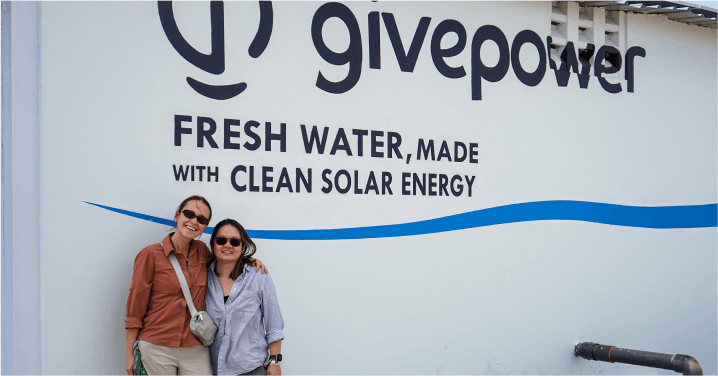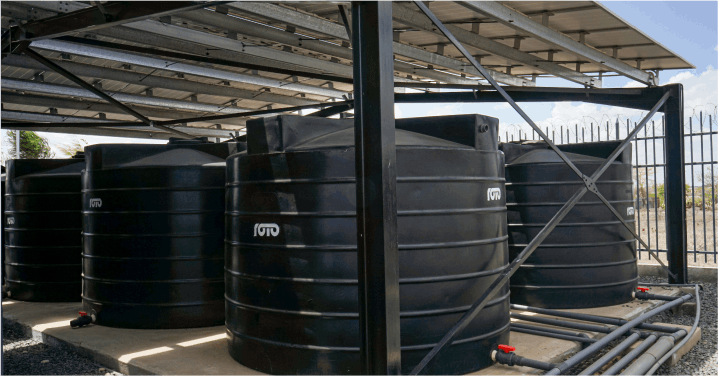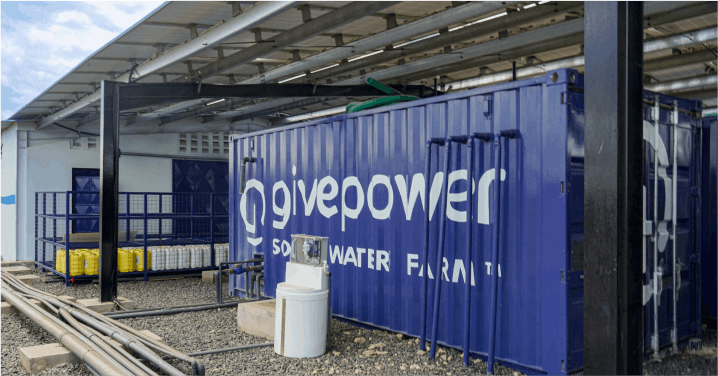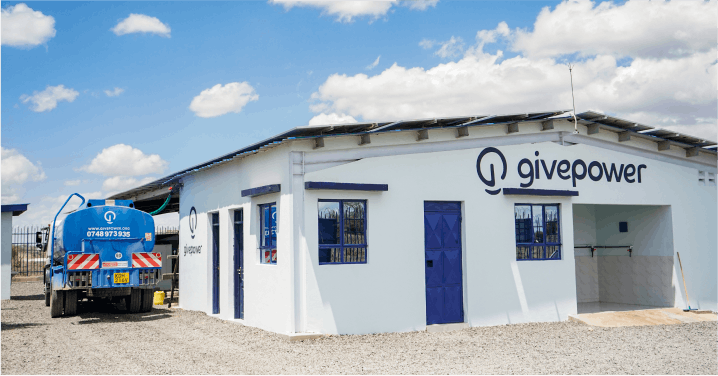
From Sun to Tap: Inspire and GivePower Make Clean Water More Accessible in Kitengela
Inspire Clean Energy
May 18, 2023
6 min read
category: Brighter World Project
Don't worry about climate change— do something about it.
Our clean energy plans are the easiest way to reduce your home's carbon footprint.
Switch to clean energyImagine living in a community where you have to walk miles every day just to fetch clean water for your family. In Kenya, it’s not uncommon for women and children to spend a third of their day under the scorching sun trying to procure the most precious of natural resources: fresh water.*
The Water Crisis in Kenya
You may have heard that countries contributing the least to climate change are often impacted the most. Kenya is a prime example of that phenomenon. Despite contributing less than 0.1 percent of global greenhouse gas emissions (GHGs) annually,** the East African country is highly vulnerable to the impacts of climate change. To make matters worse, more than 80 percent of Kenya consists of arid or semi-arid land that’s more susceptible to seasonal flooding and droughts. These conditions not only significantly impact Kenya’s primary sources of revenue—agriculture, tourism, and natural resources—they exacerbate the country’s ongoing water crisis.
Unpredictable rainfall patterns, droughts, forest degradation, flooding, poor resource management, and an exponentially growing population all work in tandem to create a perfect storm of water scarcity in Kenya. And, as climate change continues to impact precipitation and evaporation rates, the dependability of both surface and groundwater is becoming increasingly concerning—particularly during dry spells and droughts. This leaves approximately half of the country’s 53 million residents without access to safe water.***
Thirsty for Change: Kitengela’s Struggle With Water Scarcity
Kitengela, a rapidly growing town just 20 miles outside the country’s capital of Nairobi, shares a similar story. With no access to Western plumbing systems, residents rely on gravity-powered cisterns for basic water needs—including bathing, cooking, and gray water for toilets—and often have no choice but to purchase high-priced drinking water from local vendors. The town’s population growth and water shortages have led to price gouging and lack of access to clean drinking water—sometimes for weeks at a time.
GivePower and Inspire Clean Energy Team Up to Bring Water to Kitengela
In early 2021, we established the Brighter World Project, a one-for-one model that ensures for each year someone is an Inspire member, we contribute toward the development of clean energy solutions for those in critical need in partnership with the nonprofit GivePower.
Thanks to our members, we supported 287,000 people, three communities, and the installation of 86 kW of clean energy around the world in 2022 alone!”
Dana Davis, Director of Sustainability and Social Impact
When the folks at GivePower took notice of Kitengela’s plight, they seized the opportunity to make the lives of the town’s residents a little easier by fulfilling their fundamental need for access to clean drinking water through the development of a solar-powered water farm. And this spring, GivePower’s Head of Impact, Barrett Raftery, extended an invitation to a couple of our team members, Sr. Director of Impact Dana Davis and Manager of Graphic Design Cindy Man, to witness the monumental impact our partnership has on communities like Kitengela.

Inspire’s Dana Davis, Sr. Director of Impact (left), and Cindy Man, Manager of Graphic Design, visited the Kitengela Solar Water Farm in March 2023.
The Solar Water Farm Max System
If you’re not familiar with solar water farms, you’re in good hands. We’ll walk you through the details of this shining example of sustainable development (which we happen to think are pretty darn cool). To start, groundwater is sourced from a borehole on-site, so there’s no need to import it from other locations. From there, it goes through a three-step filtration process, including reverse osmosis, transforming brackish water into clean drinking water. And the whole process is powered by solar energy and backup batteries on-site! The best part is, the potable water is sold directly to the local community—at affordable rates—either on-site or through local businesses. Not only does this ensure access to clean water for the community, but it also generates revenue that can be reinvested into the project for maintenance and future expansion. Now let’s dive into some highlights of the solar water farm business model:
- CapEx funding is secured from donors and grants
- Solar water farm locations are selected based on a rigorous scoring system
- GivePower manufactures all models in its Austin, Texas, facility
- Systems are shipped and then constructed by local teams and vendors
- Local staff members are hired and trained to operate the system
- Water is distributed at the lowest possible price to cover all site operations
- Carbon credits are generated and monetized to pay for regional management staff
As if providing clean drinking water to vulnerable communities wasn’t impressive enough, the Solar Max Water system also has a significant impact on carbon avoidance, and we’ve got the bullet points to prove it:
- A single Solar Water Farm Max System avoids up to 13,000 metric tonnes of carbon each year it operates
- 1,960 liters of water sold represents 1 metric tonne of carbon avoidances irrespective of the system producing it
- Over 50,000 metric tonnes of carbon can be avoided in 2023 with the portfolio of nine operating systems in Kenya; 50,000 metric tonnes is the equivalent of 5 million mature trees
- Each system is built to remain productive for decades
The Solar Max systems used in this particular project are capable of producing up to 70,000 liters of clean water per day–enough to support up to 35,000 people daily. That’s a significant impact on the lives of the people in the community. Check out the photos below to get a better idea of how the Solar Max system works.

Water is pumped from the ground on-site. Then it travels through the black tubes and ends up in these tanks so the particulates can settle before the purifying process begins.

The solar water farm technology is built in shipping containers by the GivePower engineering team in Austin, Texas, then delivered to the site. One holds backup Tesla battery storage, while the other contains essential reverse osmosis technology. Without these two containers, solar water filtration wouldn’t be possible!

Once the water is carried through the black tubes to the black jugs (both pictured in the first image) it continues its journey by entering this container, where reverse osmosis begins.

After the water has been purified, there are two ways of distributing it. The first, pictured here, is by using GivePower’s truck, nicknamed Hope, to deliver fresh drinking water to community distributors.

The second option is for members of the community to line up at the window directly below the GivePower sign to fill up their water jugs.
On the Horizon
The devastating impact of climate change on vulnerable countries like Kenya cannot be overstated. And the country’s water crisis, exacerbated by climate change, is an urgent issue affecting millions of people. However, initiatives like this solar-powered water farm offer hope for communities like Kitengela, providing access to clean drinking water and a sustainable source of revenue. Projects like these highlight the importance of investing in sustainable development and renewable energy solutions to address the pressing environmental and social challenges we face. We’re looking forward to a long and fruitful partnership with GivePower so we can continue to help communities in need around the world.
Don't worry about climate change— do something about it.
Our clean energy plans are the easiest way to reduce your home's carbon footprint.
Switch to clean energy
Inspire Clean Energy
We're on a mission to transform the way people access clean energy and accelerate a net-zero carbon future.
Learn more about Inspire →Explore more
Recent Posts
Top Articles





















